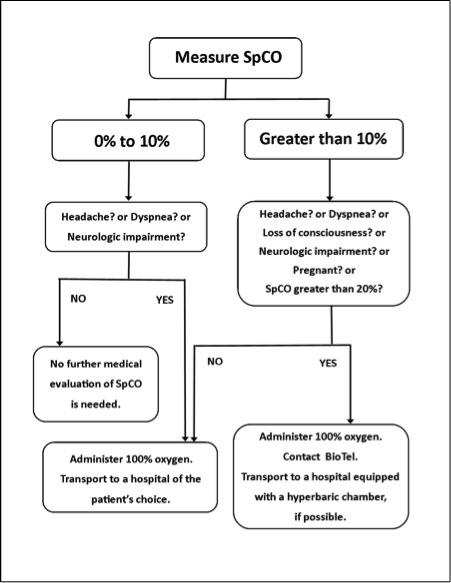CARBON MONOXIDE EXPOSURE
Purpose: These guidelines will provide direction for EMS responders using transcutaneous carbon monoxide (CO) monitors (optional equipment) while treating patients, or while monitoring firefighter exposure at the fire ground.
SPECIAL NOTE: Some patients may exhibit low CO readings and yet may still be symptomatic to various degrees. Always treat according to the patient’s symptoms. In cases of severe carbon monoxide intoxication, Texas Health Presbyterian Hospital Dallas is equipped with a hyperbaric chamber.
- INDICATIONS FOR MEASUREMENT OF CARBON MONOXIDE LEVELS:
- Smoke inhalation
- Thermal burns
- Altered level of consciousness with no clearly identifiable cause
- Assessment of fire ground personnel (e.g. fires, hazardous materials incidents, hydrocarbon-powered equipment in a closed environment)
- CLINICAL PRESENTATION ACCORDING TO SpCO LEVEL:
| SpCO level | Clinical Manifestations |
| > 5% | Mild headache |
| 10% | Mild headache, shortness of breath with exertion |
| 10% - 20% | Moderate headache, shortness of breath |
| 20% - 30% | Worsening headache, nausea, dizziness, fatigue |
| 30% - 40% | Severe headache, vomiting, vertigo, altered judgment |
| 40% - 50% | Confusion, syncope, tachycardia |
| 50% - 60% | Seizures, shock, apnea, coma |
Fire Rehab Considerations: Refer to your agency SOPs |
|
- SPECIAL NOTE: Always confirm a high reading by measuring on more than one finger on each hand. If the values differ significantly, use an average reading.
- 4. CONCURRENT USE OF PULSE OXIMETRY AND CAPNOGRAPHY: Transcutaneous carbon monoxide monitoring devices (carbon monoxide co-oximetry) may be used concurrently with both pulse oximetry (SpO2) and capnography (ETCO2) monitoring. The pulse oximetry device cannot discriminate between oxygen and carbon monoxide. Therefore, a patient may exhibit a normal SpO2 reading when serious carbon monoxide intoxication is present.

Special Note: In all cases of severe carbon monoxide intoxication, Texas Health Presbyterian Hospital Dallas is equipped with a hyperbaric chamber. Contact BioTel for further instructions.